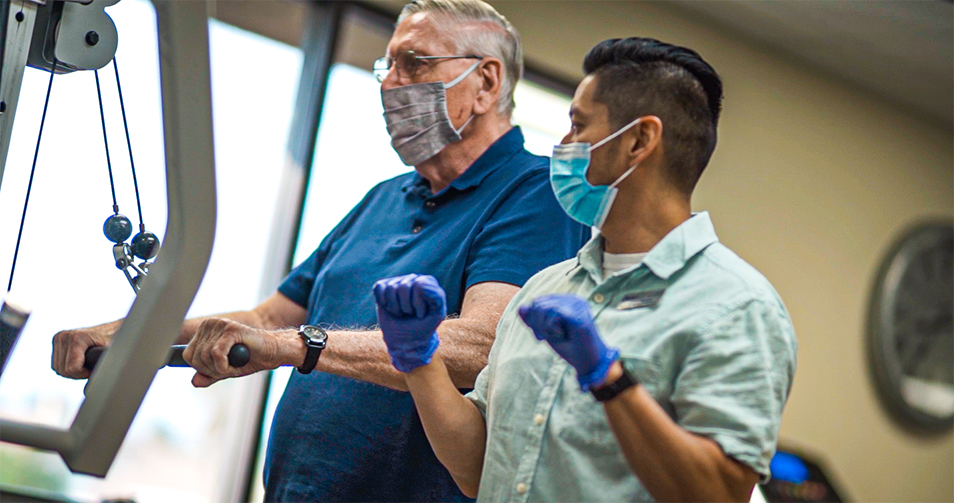Age Related Health
As we age it becomes more important than ever to keep our bodies in the best shape possible.


Arthritis symptoms can affect an individual on a daily basis. Physical therapy is a conservative, non-invasive and effective way to treat arthritis, which typically affects the articulating joints of the body such as the hip, knee, shoulder, and hand. Arthritis can also affect the spinal column known as degenerative disc disease (DDD). The primary focus of therapy is to regain overall range of motion and flexibility to help improve joint mobility as well as increase strength and endurance for improved independence with daily activities. This is accomplished in the following ways:
In addition, our physical therapy can also provide some residual benefits such as:
Osteoporosis is a common bone disorder in individuals over 40 years of age often characterized by weakened bone strength which can lead to an increased risk of bone fracture.
Osteoporosis is serious especially when you are older as broken bones cause pain and affect your quality of life. Broken bones due to osteoporosis are most common in the hip, spine and wrist, but any bone can be affected. With osteoporosis broken bones can occur with a fall, but in some individuals with the disease a break can occur with simple activities such as bending, lifting or even a sneeze. So, prevention in younger people is also very important.
Often there are no symptoms or pain with osteoporosis until a fracture occurs. Depending on your age and other risk factors, your healthcare provider may recommend a bone mineral density (BMD) test. The test will tell if you have osteoporosis or are at risk of developing it.
When you are working with Optimal Physical Therapy, our fantastic physical therapists can help prevent osteoporotic fractures with an appropriate exercise and fall prevention program. Research has shown that exercise can slow down the rate of bone loss and improve bone strength. Exercise improves mobility, muscle strength and balance, reducing the risk of falling and thereby reducing the risk of breaking a bone. Our physical therapists have specialized training and certification in orthopedic physical therapy. They will perform an evaluation and develop and train you in a safe, effective individualized exercise program for YOUR bone health needs.
Each year more than one-third of adults in the United States age 65 and older fall, and 20% to 30% of people who fall suffer moderate to severe injuries. As we age the ability to maintain balance becomes more difficult. Many factors contribute to good balance; some of them are biological, and some can be influenced and improved. Balance and stability are important factors for aging adults to maintain a healthy lifestyle, as loss of balance is the primary factor in falls, which often results in serious injuries.
Physical therapists see and treat a variety of conditions related to pain caused by falls. Physical therapists can also work with patients to identify and address the risk factors that put patients at a higher risk of falls or injury from falls. We work with our patients to assess and address factors including medication side effects, weakness, vitamin deficiency, poor vision, pain, footwear, home environment, vertigo, and balance. Most falls occur as a result of any combination of these risk factors, many of which can be addressed through our Balance and Fall Prevention treatment plan.
As many as 35% of Americans over 40 have experienced some form of vestibular dysfunction and 80% of Americans over age 65 have experienced dizziness.
Vertigo is a common condition that creates the sensation of having an unbalanced equilibrium. Vertigo is not a specific disease but rather a symptom that results from an issue in the inner ear or brain. Often, individuals experiencing vertigo suffer brief episodes of mild to intense dizziness. Benign Paroxysmal Positional Vertigo (BPPV) is typically triggered by changes in head position such as tilting your head up, down, or side-to-side. While vertigo can be bothersome, it is rarely serious. But vertigo can become dangerous as it increases your risk of falls.
Vertigo can be caused by a problem in the inner ear (peripheral vertigo), or by an issue in the brain or central nervous system (central vertigo). In the case of BPPV, small crystals of calcium carbonate that typically remain in the otolith organs (a structure in the saccule or utricle of the inner ear) enter the semicircular canal located in the inner ear. These dislodged crystals cause the brain to receive confusing messages about your body’s position. While vertigo can occur at any time, it is most common in individuals who have suffered head injuries or are using certain medications. In some individuals, alcohol consumption can also trigger vertigo.
Symptoms of vertigo can last a few minutes to a few hours or more and may come and go. At Optimal Therapy, we treat a variety of Vestibular Disorders that can make you feel dizzy or off balance, affecting the quality of your everyday life. Conditions treated may include:
Did you know: More than 16 million Americans have chronic obstructive pulmonary disease. Millions more have it and don’t know it.
Pulmonary disease (also called respiratory disease or lung disorder) can impact lungs and the respiratory system. Chronic obstructive pulmonary disease (COPD), asthma, lung cancer, pneumonia, and pulmonary fibrosis are included. For any individuals challenged by chronic pulmonary disease, we can help!
This program helps improve pacing and energy conservation through the following methods:
If you have recently been diagnosed with Pulmonary Disease, or are worried it has been undiagnosed, contact your nearest Optimal Therapy for an evaluation. Our friendly and skilled therapists offer a variety of therapy options to help patients manage the disease and continue their favorite activities.
If you want to skip the wait, you can reach our scheduling team Monday through Friday from 9am – 5pm.